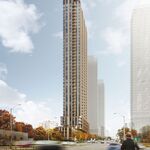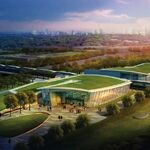The Mad Navigator
Banned
Wait, I thought that was CC's job? He does live in the Imperial City afterall...
PS: I edited your post slightly
LRT: We have cookies!
Wait, I thought that was CC's job? He does live in the Imperial City afterall...
PS: I edited your post slightly
Ottawa made the right choice in cancelling the 1st LRT project. Plain and simple. The thing was absolute garbage. It makes the SELRT look like a great idea. Half of the line went through corn fields for f* sake!
I don't buy this "oh they should have just started it, then changed it while it was underway" argument. Get the plan right, then build it. If the plan isn't right, don't build it. And who are these "transit advocates" that you speak of? I have yet to speak to anyone involved in the transit planning world in Ottawa who preferred the old plan over the new one. The only people who do are developers in Riverside south, and the old mayor. Any transit planner with half a brain could have told you that running LRT at-grade through downtown was a bad idea. Hell, the tunnel was even studied as part of the original Transitway BRT plan in the 70s! The at-grade option was chosen because it would have raised the cost of the project substantially, and at that point the added capacity of a tunnel wasn't needed. If you've ever stood downtown waiting for the 95, 96, or 97 bus at rush hour, you'd agree that the extra capacity is definitely needed, and simply swapping out buses for trains would have done nothing.
So yes, Ottawa did make the right decision in cancelling it, and I'm glad that my city council actually had the balls to stand up for what was right. The taxpayers paid a small price for it, but it's a smaller price to pay than living with a mistake for the next 20-30 years. I only hope that Torontonians will take a page from Ottawa's book, and take a step back, and get it right. The people of Ottawa actually had the guts to stand up and say "at-grade LRT along primary corridors is not good enough". And look what they're getting: grade-separated LRT instead.
Ottawa made the right choice in cancelling the 1st LRT project. Plain and simple. The thing was absolute garbage. It makes the SELRT look like a great idea. Half of the line went through corn fields for f* sake!
I don't buy this "oh they should have just started it, then changed it while it was underway" argument. Get the plan right, then build it. If the plan isn't right, don't build it. And who are these "transit advocates" that you speak of? I have yet to speak to anyone involved in the transit planning world in Ottawa who preferred the old plan over the new one. The only people who do are developers in Riverside south, and the old mayor. Any transit planner with half a brain could have told you that running LRT at-grade through downtown was a bad idea. Hell, the tunnel was even studied as part of the original Transitway BRT plan in the 70s! The at-grade option was chosen because it would have raised the cost of the project substantially, and at that point the added capacity of a tunnel wasn't needed. If you've ever stood downtown waiting for the 95, 96, or 97 bus at rush hour, you'd agree that the extra capacity is definitely needed, and simply swapping out buses for trains would have done nothing.
So yes, Ottawa did make the right decision in cancelling it, and I'm glad that my city council actually had the balls to stand up for what was right. The taxpayers paid a small price for it, but it's a smaller price to pay than living with a mistake for the next 20-30 years. I only hope that Torontonians will take a page from Ottawa's book, and take a step back, and get it right. The people of Ottawa actually had the guts to stand up and say "at-grade LRT along primary corridors is not good enough". And look what they're getting: grade-separated LRT instead.
How did urbantoronto become a forum for discussing Ottawa transit iissues?
As a resident of Ottawa, I will have to side with Waterloo Warrior. Some of what you say is true, however, the N-S LRT line was being used as a planning tool in order address peculiar transportation issues to the locations it was going to serve. It was also being directed at a market where transit was being underutilised. It was also trying to direct development into an area which could be served by rapid transit and take some of the pressure off of eastward and westward sprawl, where the city has no hope of offering rail rapid transit within the next generation and likely longer. The cost is simply too high to do so and the corridors lacking or difficult. I can't emphasize enough about the lost opportunity costs that Ottawa has experienced and the fact that the original plan is still slated to be built at some point. This shows the folly of cancelling projects that had already been approved, funded and contracts signed. Ottawa will never recover what was lost as a result of that cancellation. I also wish to point out how difficult it is for a mid sized city to finance a subway. What is spent tunneling means much less track can be laid. I fear the Edmonton example where a tunnel was built and LRT then stalled for a generation because the benefits could not easily be seen from a short LRT line. I for one believe that N-S LRT line would have built momentum faster towards the construction of additional lines and the tunnel. The N-S line could have been in operation right now, and the tunnel plans could have been just as advanced with the same funding in place. In my opinion, the current mayor who cast the deciding vote in December 2006 to cancel the N-S LRT plan could have had that line plus his tunnel and the city would have been that much further ahead. He made a foolish mistake and there is still no guarantee that the tunnel will be built. On the point of what is the better plan, that is not really a fair question, because the scale of the two projects are different. If we ever get going, and that is still a big IF, both projects will ultimately be built. Cancellation of a project that will be built anyways just illustrates the stupidity of it all.
All,
Can someone please answer this (silly) question: If and when these four Light Rail Lines are done (by 2020 or so), will they actually be a continuous flow, in that, they would connect with each other so riders wouldn't have to transfer from one line to another or people will have to physically get off one line and onto another at each key station (like say Kennedy to go from Eglinton to Scarborough line)? It would probably be too good to be true to have a seamless connection with the four lines (i.e. one can go from Humber College station to Jane Station without transferring)? Thanks.



Out of curiousity, how will the SELRT tunnel be built? I am assuming TBM's to tunnel under the 404? Will it even be ready by 2014?
My guess is cut-and-cover. The reason they went with an LRT tunnel to Don Mills rather than a subway tunnel to Consumers was that they'd be able to make the LRT tunnel shallow, while a subway tunnel would have to be deep.




